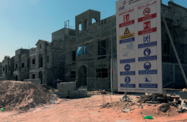Major infrastructure projects and extensive plans to galvanise residential construction have fuelled demand for building materials in Saudi Arabia, prompting the government to intervene in the cement market for the second time in as many years. Steel, another vital building material, is also experiencing consistently high demand in the Kingdom.
A royal decree issued on April 16 paved the way for the country to import 10m tonnes of cement as a means of making up shortfalls in the immediate term. While this is a short-run solution to a supply shortage, the government will also channel $800m into constructing up to four new cement plants over the next three years. The new factories are expected to add 12m tonnes to production capacity, which stood at 47m tonnes in 2012.
A number of other facilities are in the works. Tabuk Cement announced plans in June to roll out a new $141m clinker plant, which is set to be operational by the end of 2015. Eastern Province Cement, meanwhile, said in February that it had earmarked $21.86m to build a cement mill, while in May, Najran Cement awarded the Chinese firm, CEIC, a contract to install a third production line.
The shortage of cement has been a challenge for some time. Last year the government took steps to keep down prices, first by banning export of the product in February 2012 and then intervening in a dispute between Saudi Aramco and cement producers one month later to ensure that the state-owned oil and gas company supplied the latter with fuel. The government’s efforts to ease the constraints on Saudi Arabia’s builders also saw the administration lower the price ceiling for a tonne of cement to SR240 ($63.98) from SR250 ($66.65).
Saudi Arabia’s population is growing at a rate of 2.9%, having risen above 29m in 2012, according to the Central Department of Statistics and Information. Changing demographics have prompted the government to invest heavily in infrastructure projects, including housing and transportation initiatives. A 2012 report published by Standard Bank said that the Kingdom had earmarked around $67bn for 500,000 housing units, $44.6bn for a broad range of infrastructure projects and $39bn for other construction developments.
The cement shortage is particularly acute in the Western Region, where much of the new construction is located. “If capacity is not increased, there will be over-demand soon, particularly as a result of the huge demand coming from Medina,” Eisa Baeisa, the CEO of Tabuk Cement, told OBG. “All the cement factories are serving projects there.”
Demand for building materials has also been driven up by the $6bn Haramain High-Speed Rail project, which, once finalised, will connect Mecca and Medina via King Abdullah Economic City, Rabigh, Jeddah and King Abdulaziz International Airport.
Saudi Arabia’s huge infrastructure programme has also increased demand for steel. A report released by market research firm RNCOS noted that steel consumption in the Kingdom witnessed double-digit growth last year, with demand forecast to continue rising by more than 11% annually until 2017.
Saudi Basic Industries Corporation (SABIC) responded to market pressures by announcing plans in June to construct two new steel plants with a total annual processing capacity of 2.5m tonnes. The Saudi government holds a 70% share in SABIC, which is the world’s largest petrochemical company.
The Kingdom’s efforts to address the challenges of rising demand for construction materials will be welcomed by the building industry. However, with the Saudi construction boom showing no signs of easing, suppliers are likely to remain under pressure in the coming years, until long-term solutions take effect.

